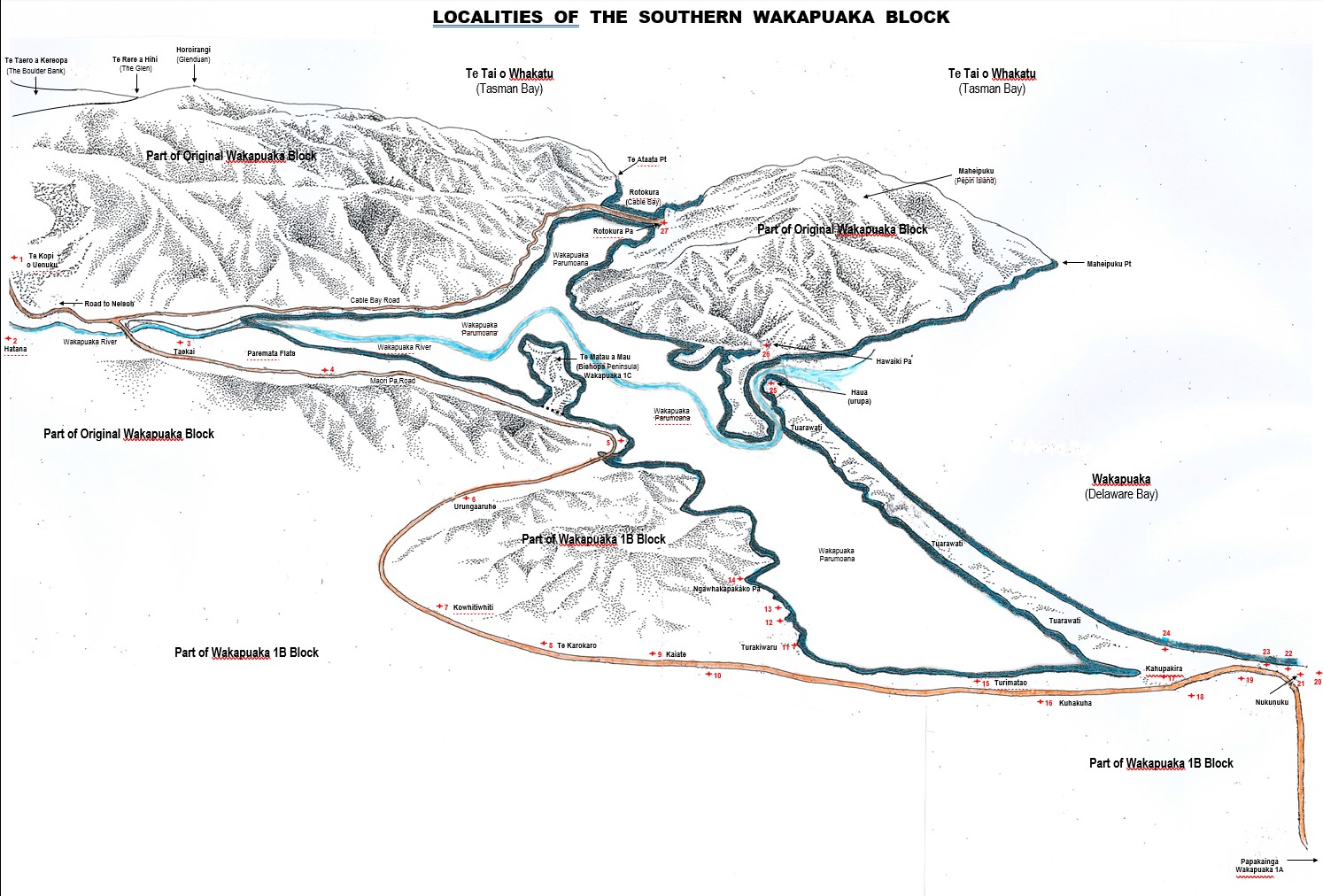Wakapuaka Kāinga sites
Wakapuaka Block – Original Native Title In 1880 when Wi Katene Te Puoho, chief of Ngāti Tama died, the status of the more than 17,500 acres (7,100 ha) at Wakapuaka, was Original Native Title; the block was bounded on the north at Kokorua Inlet, to the east by the Whangamoa River,…
Wakapuaka Block – Original Native Title
In 1880 when Wi Katene Te Puoho, chief of Ngāti Tama died, the status of the more than 17,500 acres (7,100 ha) at Wakapuaka, was Original Native Title; the block was bounded on the north at Kokorua Inlet, to the east by the Whangamoa River, to the south by a line from the Glen to Whangamoa Hill, and by the western sea coast between the Glen and Kokorua. Traditionally the land would have been regarded as communally-owned by those members of the iwi who had accompanied Wi Katene’s father, Te Puoho ki Te Rangi, in the invasion of the late 1820s and early 1830s which saw Ngāti Tama secure rights to Wakapuaka. During Wi Katene’s lifetime the Ngāti Tama families among the 90+ residents were unconcerned about matters of ownership of the large block.
Succession to Individual Ownership
In 1883 Wi Katene’s daughter, Hūria Mātenga, applied to the Native Land Court to succeed to the title of Wakapuaka; the Court determined she was the sole owner of the Wakapuaka Block. This decision led to considerable unrest among members of her whanau and other Ngāti Tama who, until then, had enjoyed more than fifty years of traditional pursuits and secure occupation as residents at Wakapuaka. Between 1883 and Hemi Mātenga’s death in 1912 approximately 5,000 acres of Wakapuaka was sold.
Protests, Appeals, Petitions, Submissions, Lobbying
A long series of protests, appeals, petitions, submissions and lobbying followed the 1883 judgement – to the Native Land Court, the Department of Native/Māori Affairs, and/or Parliament - led largely by descendants of Paremata Te Wahapiro, half-brother of Wi Katene Te Puoho. The situation was exacerbated by Hūria Mātenga’s will which left the estate to her husband, Hemi Mātenga, when she died in 1909.
For almost four decades attempts by Paremata’s descendants to have their grievances heard were turned down; finally, in 1934, the Government approved an investigation by Judge Harvey, followed by further arguments in the Māori Appellate Court in 1937 and 1939. The witnesses who testified included the elderly Ngāwaina Hanikamu (née Paremata), Hari Wi Katene, and Ihaka Te Rei. The Courts eventually awarded 25% of the residue of the Wakapuaka lands, amounting to approximately 3,641 acres (1,473ha) to 19 descendants of Paremata Te Wahapiro, formalised by a title deed in 1944. This 25% comprised the more valuable southern portion of the block, with greater potential for sheep and beef farming than the steep hills of the northern 75%.
Other families of Ngāti Tama resident at Wakapuaka were not included in the Court’s award, and the Courts confirmed that the 75% of the residual lands at Wakapuaka remained with Hemi Mātenga’s estate, the bulk of which, following his death in 1912, was inherited by the children of his brother, Wi Parata Kakakura of Waikanae. Hemi’s will made provision for his daughter Mamae (by Ngāwaina Paremata) to inherit the house and 338 acres at Wakapuaka. Mamae predeceased Hemi by 11 days; her two children, Reuben and Konehu Stephens inherited.
During the 1930s Court hearings, elderly witnesses identified named localities within the Wakapuaka block, listed residents at various kainga, and their movements. The perspective plan accompanying this narrative summarises this information.
Partitions
Partition orders at the 1944 hearing, applied for at the instigation of the 19 descendants of Paremata, divided the 25% awarded to them into three blocks: Wakapuaka 1A, Wakapuaka 1B and Wakapuaka 1C:
- Wakapuaka 1A of approximately 10 acres, at the northern end of the awarded block is known as the Papakainga Block
- Wakapuaka 1C - Te Matau Mau or Bishops Peninsula of approximately 20.5 acres was set aside by the new owners as a historic nature reserve
- The bulk of the estate is administered as a Maori Incorporation, Wakapuaka 1B.
The remaining 75% held by the Parata whanau was sold after the Court decision.
2022
Story by: Mitchell Research

